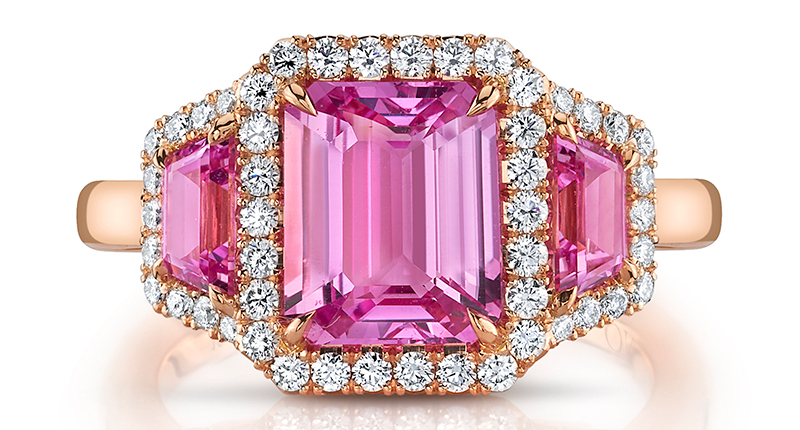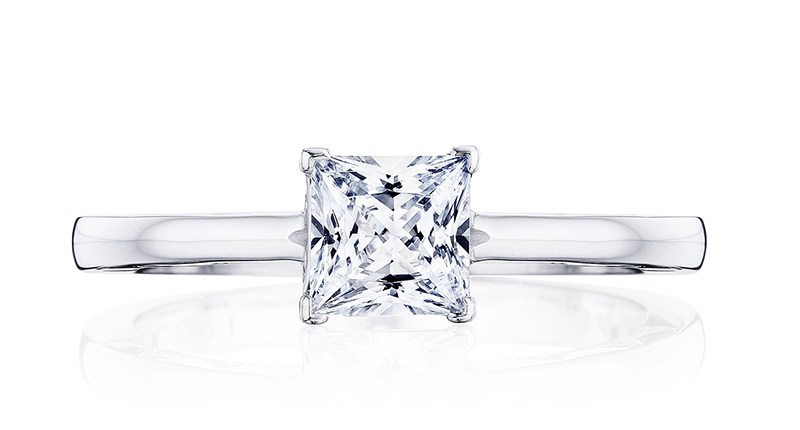Articles about crime, engagement rings, and a necklace worn in the World Series generated the most interest among readers.
The Average Amount Spent on an Engagement Ring Is …
Lower than it was a couple years ago, according to The Knot, De Beers and industry analyst Edahn Golan.

New York—Couples are spending about 7 to 9 percent less on their engagement rings than they did two years ago, data collected from multiple sources shows.
According to The Knot’s 2019 Jewelry & Engagement Study released last week, the national average spend on an engagement ring in the United States stands at $5,900.
By region, the average cost is: $7,500 in the Mid-Atlantic states; $6,900 in New England; $5,600 in the Southwest; $5,500 in the West; $5,400 in the Southeast; and $5,300 in the Midwest.
The figures released by The Knot in its report—which comes out every two years and is the company’s deep-dive into engagements and the jewelry that accompanies them—consistently come in above the averages documented by industry sources.
Analyst Edahn Golan said his data, which is collected from hundreds of stores across the United States that vary by geography, size, type and positioning, shows the average expenditure on diamond engagement rings today is about $3,200.
Golan’s figure is on par with that of De Beers Group, which has U.S. engagement ring expenditure averaging $3,400 in its latest Diamond Insight Report, released last week.
While The Knot’s number comes in above the figures provided by Golan and De Beers, all three data sets show spending on engagement rings going in the same direction: down.
The Knot’s $5,900 average is down 7 percent from $6,351 in 2017, the last time it conducted its jewelry and engagement study.
Golan’s $3,200 figure represents a nearly 9 percent decline from the $3,500 he said couples were spending just a couple years ago.
And De Beers’ average has dropped too, from $3,700 in 2013 to $3,400 in 2017.
Golan said the primary driver behind the decline in engagement ring expenditure is the shift to smaller center stones, which is part of a wider change in taste and fashion. Many consumers today are opting for daintier styles in engagement rings (as well as in jewelry in general) even if cost is not an issue for them.
“This is the larger driver [of the trend],” he said. “Economic drivers are there too, but they are largely secondary.”
The Knot saw the same when conducting its jewelry study, with the size of the stone declining in importance when compared to the piece’s cost and overall quality.
Worldwide Senior Director of Insights Lauren Goodson said when The Knot asked couples which engagement ring features are most
The size of the ring, meanwhile, dropped two slots in importance for proposers and three spots for proposees, ranking second to last this year (out of eight) for all, compared to fifth for proposers and fourth for proposees in 2017, she said.
Diamonds Vs. Other Gemstones
In addition to price, The Knot’s study, which included both engaged and recently married couples, delved into questions of ring style, center stone choice and proposal procedures.
Overall, the survey showed exchanging a ring of some sort remains the overwhelming custom in the U.S., with 97 percent of couples doing so when they get engaged.
And the most popular center stone remains a colorless or near-colorless diamond, purchased by 86 percent of respondents. (Golan said this has been the case historically, with diamonds holding about an 85-90 percent market share for engagement rings.)

Accounting for the remaining 4 percent of responses to the center stone question were colored diamonds (3 percent) and couples who said they exchanged rings with no center stones (1 percent).
The Knot did ask survey-takers the lab-grown question, with 15 percent of proposees stating they prefer to have a lab-grown stone and 12 percent reporting they actually have one.
Goodson confirmed the study did not specify which kind of lab-grown stone, however, so it cannot be assumed they are all man-made diamonds.
Style Profile
It will come as no surprise to jewelers that customization also emerged as a big trend in The Knot’s survey, with nearly half (45 percent) of new rings purchased for an engagement including some custom details.
This includes taking an existing design and adding personal touches (51 percent) or designing a ring from scratch (31 percent).
Round diamonds still remain the most popular, retaining nearly 50 percent market share.
Ovals tied square/princess cuts for second place at 14 percent each, followed by the cushion cut at 9 percent. Rounding out the top five most popular cuts was the pear at 5 percent.
More than half of respondents picked white gold for their setting, followed by rose gold (14 percent), platinum (13 percent), yellow gold (13 percent) and sterling silver (7 percent).

Other findings from the survey include the following.
— Nearly a quarter (22 percent) of those surveyed met online, up from 5 percent in 2017. The most popular platforms were Tinder (30 percent), OkCupid (14 percent) and Bumble (13 percent).
— A total of 65 percent of survey-takers are at least 25 years old when they propose. Thirty-eight percent are 25 to 29, while 27 percent are between 30 and 34 years old.
— When people start looking for their engagement rings, social media (79 percent) and jewelry designers’ websites (25 percent) are their go-to sources for inspiration.
— A small percentage of couples (7 percent) do a dual proposal and another 7 percent report giving each other rings.
RELATED CONTENT: Propose Too: A Platform That Wants Women to Pop the Question— Right after they get engaged, a whopping 92 percent of happy couples take to social media to share the news (and, presumably, the ring). Three-quarters of survey-takers said they call family and friends and 72 percent send them photos of the ring.
— While members of younger generations are widely touted as breaking with tradition to make everything “their own,” The Knot’s study shows there are quite a few long-standing proposal customs that are still widely used.
Nearly 90 percent of proposers have the ring in hand when they pop the question, 87 percent say, “will you marry me?”, 84 percent ask on bended knee and 71 percent ask permission from their partner’s parent(s) before proposing.
The Latest

As part of the leadership transition, Sherry Smith will take on the role of vice president of coaching strategy and development.

It marks the third time the country has headed the Kimberley Process. Ghana will serve as vice chair.

How Jewelers of America’s 20 Under 40 are leading to ensure a brighter future for the jewelry industry.

The new Bulova x Stetson designs highlight two animals often associated with the American West—the bison and the Texas Longhorn.


Its residency at Yamron Jewelers will run through May 2026.

From influential executives to innovative designers, we pay tribute to the people we said goodbye to this year.

Roseco’s 704-page catalog showcases new lab-grown diamonds, findings, tools & more—available in print or interactive digital editions.

The retailer is expanding into areas with large Indian and South Asian populations.

The Italian brand has opened its first flagship amid the peaks of the Dolomites in Madonna di Campiglio, Italy.

The new curation at the Natural History Museum of Los Angeles County showcases rare gem and mineral specimens in their uncut, natural state.

The couple pleaded guilty to concealing at least $127 million in cash transactions at its precious metals businesses.

In February 2026, the auction house will move its headquarters to the former Steinway Hall, a neoclassical landmark on Billionaires’ Row.

The new show will take place Jan. 23-25, 2026.

The former BHP Billiton leader and Gemfields chairman is remembered for his influential leadership throughout his 50-year mining career.

The LVMH-owned brand has partnered with the costume design union to revamp its award for 2026.

The luxury titan inked a deal to acquire an initial minority stake in the jewelry manufacturer with a pathway to full ownership by 2032.

The company’s curation of unsigned vintage and estate jewelry debuted at the Bloomingdale’s in Costa Mesa, California.

In the recent multi-shipment seizure, CBP also found counterfeit Audemars Piguet, Moncler, and Chrome Hearts items.

Helzberg’s Chief Retail Officer Mitch Maggart shared details about its tests of a new store concept rooted in an elevated luxury experience.

Jewelers of America execs and National Jeweler editors discuss tariffs, the sky-high gold price, and the engagement that broke the internet.

The luxury goods company said founder Ippolita Rostagno will remain at the brand’s helm.

Laura Burdese, who joined the Italian luxury brand in 2022, will take on the role in July.

The National Jeweler editors revisit the most noteworthy industry happenings and design trends from 2025.

Need a gift for the cat lover who has everything? Look no further than our latest Piece of the Week.

It purchased the “Grosse Pièce,” an ultra-complicated Audemars Piguet pocket watch from the ‘20s, for a record-breaking price at Sotheby’s.

The lab-grown diamond grower now offers custom engagement and fashion jewelry through its Kira Custom Lab Jewelry service.



























